Food Security Sustainability: A Synthesis of the Current Concepts and Empirical Approaches for Meeting SDGs
Abstract
:1. Introduction
Distribution of Food Insecurity in Nigeria
2. Literature Review
2.1. Economic Perspectives of Food Security
2.2. Political and Societal Conflict Perspectives
2.3. Environment, Natural Resources, and Food Production
2.4. Neo Malthusian Theory and Theory of Access Connection to Food Security
3. Materials and Methods
3.1. Model Specification and Data Description
3.2. Estimation Techniques
4. Results
4.1. Descriptive Statistics
4.2. Johansen Cointegration Test
5. Discussion
6. Conclusions
6.1. Policy Implications
6.2. Limitations
Author Contributions
Funding
Institutional Review Board Statement
Informed Consent Statement
Data Availability Statement
Conflicts of Interest
References
- Petit, G.; Yannou-Le Bris, G.; Eckert, C.; Liu, Y. Facilitating Aligned Co-Decisions for More Sustainable Food Value Chains. Sustainability 2021, 13, 6551. [Google Scholar] [CrossRef]
- Schleifer, P.; Sun, Y. Reviewing the impact of sustainability certification on food security in developing countries. Glob. Food Secur. 2020, 24, 100337. [Google Scholar] [CrossRef]
- Nicholson, C.F.; Stephens, E.C.; Kopainsky, B.; Thornton, P.K.; Jones, A.D.; Parsons, D.; Garrett, J. Food security outcomes in agricultural systems models: Case examples and priority information needs. Agric. Syst. 2021, 188, 103030. [Google Scholar] [CrossRef]
- USDA Definitions of Food Security. Available online: https://www.ers.usda.gov/topics/food-nutrition-assistance/food-security-in-the-us/definitions-of-food-security.aspx (accessed on 8 April 2021).
- Neven, D. Developing Sustainable Food Value Chains, Guiding Principles; FAO: Roma, Italy, 2014; Available online: http://www.fao.org/3/i3953e/i3953e.pdf (accessed on 1 May 2021).
- Food and Agricultural Organization of the United Nation. Trade Reforms and Food Security: Conceptualizing the Linkages. 30 December 2003. Available online: http://www.fao.org/3/y4671e/y4671e00.htm (accessed on 1 May 2021).
- Nicholson, C.F.; Stephens, E.; Jones, A.D.; Kopainsky, B.; Parsons, D.; Garrett, J. Setting Priorities to Address the Research Gaps between Agricultural Systems Analysis and Food Security Outcomes in Low- and Middle-Income Countries. 2019. Available online: https://bora.uib.no/bora-xmlui/handle/1956/22090 (accessed on 1 May 2021).
- Anderson, K. Krueger, Schiff, and Valdés Revisited: Agricultural Price and Trade Policy Reform in Developing Countries since 1960. Appl. Econ. Perspect. Policy 2010, 32, 195–231. [Google Scholar] [CrossRef]
- Haruna, A. FAO Distributes Seeds, Fertiliser to Farmers Displaced by Boko Haram. Available online: https://www.premiumtimesng.com/regional/nnorth-east/273955-fao-distributes-seeds-fertiliser-to-farmers-displaced-by-boko-haram.html (accessed on 26 June 2021).
- Muyanga, M.; Jayne, T.S. Effects of rising rural population density on smallholder agriculture in Kenya. Food Policy 2014, 48, 98–113. [Google Scholar] [CrossRef] [Green Version]
- Fasanya, I.O.; Odudu, T.F. Modeling return and volatility spillovers among food prices in Nigeria. J. Agric. Food Res. 2020, 2, 100029. [Google Scholar] [CrossRef]
- Food and Agricultural Organization of the United Nation. FAO Nigeria Agriculture at a Glance. Available online: http://www.fao.org/nigeria/fao-in-nigeria/nigeria-at-a-glance/en/ (accessed on 15 July 2021).
- FAO Food and Agriculture Organization of the United Nations. Northeastern Nigeria—Situation Report December 2018: FAO in Emergencies. Available online: http://www.fao.org/emergencies/resources/documents/resources%20detail/en/c/1174427/ (accessed on 28 July 2021).
- CBN. Anchor Borrowers Programme Guidelines. Development Finance Department Central Bank of Nigeria. Available online: https://www.cbn.gov.ng/out/2017/dfd/anchor%20borrowers%20programme%20guidelines%20-dec%20%202016.pdf (accessed on 25 June 2021).
- Christensen, C. Progress and Challenges in Global Food Security. Available online: https://www.ers.usda.gov/amber-waves/2018/januaryfebruary/progress-and-challenges-in-global-food-security/ (accessed on 18 March 2021).
- Nechifor, V.; Ramos, M.P.; Ferrari, E.; Laichena, J.; Kihiu, E.; Omanyo, D.; Musamali, R.; Kiriga, B. Food security and welfare changes under COVID-19 in Sub-Saharan Africa: Impacts and responses in Kenya. Glob. Food Secur. 2021, 28, 100514. [Google Scholar] [CrossRef] [PubMed]
- Putra, A.W.; Supriatna, J.; Koestoer, R.H.; Soesilo, T.E.B. Differences in Local Rice Price Volatility, Climate, and Macroeconomic Determinants in the Indonesian Market. Sustainability 2021, 13, 4465. [Google Scholar] [CrossRef]
- George, J.; Adelaja, A. Forced Displacement and Agriculture: Implications for Host Communities. Sustainability 2021, 13, 5728. [Google Scholar] [CrossRef]
- Arias, M.A.; Ibáñez, A.M.; Zambrano, A. Agricultural production amid conflict: Separating the effects of conflict into shocks and uncertainty. World Dev. 2019, 119, 165–184. [Google Scholar] [CrossRef] [Green Version]
- Olper, A.; Curzi, D.; Swinnen, J. Trade liberalization and child mortality: A Synthetic Control Method. World Dev. 2018, 110, 394–410. [Google Scholar] [CrossRef]
- Dorosh, P.A.; Rashid, S.; van Asselt, J. Enhancing food security in South Sudan: The role of markets and regional trade. Agric. Econ. 2016, 47, 697–707. [Google Scholar] [CrossRef]
- Tinta, A.A.; Sarpong, D.B.; Ouedraogo, I.M.; Al Hassan, R.; Mensah-Bonsu, A.; Ebo Onumah, E.; Yildiz, F. The effect of integration, global value chains and international trade on economic growth and food security in ECOWAS. Cogent Food Agric. 2018, 4, 1465327. [Google Scholar] [CrossRef]
- Devereux, S.; Bene, C.; Hoddinott, J. Conceptualising COVID-19’s impacts on household food security. Food Secur. 2020, 12, 769–772. [Google Scholar] [CrossRef]
- Vanlauwe, B.; Bationo, A.; Chianu, J.; Giller, K.E.; Merckx, R.; Mokwunye, U.; Ohiokpehai, O.; Pypers, P.; Tabo, R.; Shepherd, K.D.; et al. Integrated soil fertility management: Operational definition and consequences for implementation and dissemination. Outlook Agric. 2010, 39, 17–24. [Google Scholar] [CrossRef] [Green Version]
- Sanchez, P.A. Soil fertility and hunger in Africa. Science 2002, 295, 2019–2020. Available online: http://citeseerx.ist.psu.edu/viewdoc/download?doi=10.1.1.362.6021&rep=rep1&type=pdf (accessed on 18 March 2021). [CrossRef] [PubMed] [Green Version]
- Upton, J.; Constenla-Villoslada, S.; Barrett, C. Caveat Utilitor: A Comparative Assessment of Resilience Measurement Approaches; Cornell University working paper; Cornell University: Ithaca, NY, USA, 2020; Available online: http://barrett.dyson.cornell.edu/files/papers/Resilience%20measurement%20May%202020%20submitted%20with%20appendix.pdf (accessed on 19 March 2021).
- Revoredo-Giha, C.L. Food Security Indicators, Measurement, and the Impact of Trade Openness. Eur. Rev. Agric. Econ. 2009, 36, 284–286. [Google Scholar] [CrossRef]
- Wichern, J.; van Heerwaarden, J.; de Bruin, S.; Descheemaeker, K.; van Asten, P.J.A.; Giller, K.E.; van Wijk, M.T. Using household survey data to identify large-scale food security patterns across Uganda. PLoS ONE 2018, 13, e0208714. [Google Scholar] [CrossRef]
- Eklund, L.; Degerald, M.; Brandt, M.; Prishchepov, A.V.; Pilesjö, P. How conflict affects land use: Agricultural activity in areas seized by the Islamic State. Environ. Res. Lett. 2017, 12, 054004. [Google Scholar] [CrossRef] [Green Version]
- Gorsevski, V.; Kasischke, E.; Dempewolf, J.; Loboda, T.; Grossmann, F. Analysis of the Impacts of armed conflict on the Eastern Afromontane forest region on the South Sudan—Uganda border using multitemporal Landsat imagery. Remote Sens. Environ. 2012, 118, 10–20. [Google Scholar] [CrossRef]
- Bozzoli, C.; Brück, T. Agriculture, Poverty, and Postwar Reconstruction: Micro-Level Evidence from Northern Mozambique. J. Peace Res. 2009, 46, 377–397. [Google Scholar] [CrossRef]
- Hecht, S.B.; Kandel, S.; Gomes, I.; Cuellar, N.; Rosa, H. Globalization, Forest Resurgence, and Environmental Politics in El Salvador. World Dev. 2006, 34, 308–323. [Google Scholar] [CrossRef]
- Ordway, E.M. Political shifts and changing forests: Effects of armed conflict on forest conservation in Rwanda. Glob. Ecol. Conserv. 2015, 3, 448–460. [Google Scholar] [CrossRef] [Green Version]
- Kah, H.K. ‘Boko Haram is losing, but so is food production’: Conflict and food insecurity in Nigeria and Cameroon. Afr. Dev. 2017, 42, 177–196. Available online: https://www.jstor.org/stable/90018140 (accessed on 18 March 2021).
- Awodola, B.; Oboshi, A. Terrorism in Northern Nigeria: A Threat to Food Security in Maiduguri. Mediterr. J. Soc. Sci. 2015, 6, 11. [Google Scholar] [CrossRef]
- CBC NEWS. Islamic Militants Drive 19,000 Rice Farmers off Land in Northeast Nigeria. Available online: https://www.cbsnews.com/news/islamic-militants-drive-19000-rice-farmers-off-land-in-northeast-nigeria/ (accessed on 26 April 2021).
- Sanchez, P.A.; Swaminathan, M.S. Cutting world hunger in half. Science 2005, 307, 357–359. Available online: http://www.jstor.com/stable/3840037?seq=1&cid=pdf (accessed on 18 March 2021). [CrossRef] [Green Version]
- SSSA. Replenishing Soil Fertility in Africa. Soil Sci. Soc. Am. 1997, 51, 111–149. [Google Scholar] [CrossRef]
- Franke, A.C.; van den Brand, G.J.; Vanlauwe, B.; Giller, K.E. Sustainable intensification through rotations with grain legumes in Sub-Saharan Africa: A review. Agric. Ecosyst. Environ. 2018, 261, 172–185. [Google Scholar] [CrossRef] [PubMed]
- Dixon, J.A.; Gibbon, D.P.; Gulliver, A. Farming Systems and Poverty: Improving Farmers’ Livelihoods in a Changing World; Food & Agriculture Organization: Rome, Italy, 2001; Available online: http://www.fao.org/3/ac349e/ac349e.pdf (accessed on 18 March 2021).
- Minot, N. Food price volatility in sub-Saharan Africa: Has it really increased? Food Policy 2014, 45, 45–56. [Google Scholar] [CrossRef] [Green Version]
- Frelat, R.; Lopez-Ridaura, S.; Giller, K.E.; Herrero, M.; Douxchamps, S.; Andersson Djurfeldt, A.; Erenstein, O.; Henderson, B.; Kassie, M.; Paul, B.K.; et al. Drivers of household food availability in sub-Saharan Africa based on big data from small farms. Proc. Natl. Acad. Sci. USA 2016, 113, 458–463. [Google Scholar] [CrossRef] [Green Version]
- Ehrlich, P.R.; Ehrlich, A.H. The Population Explosion; Simon and Schuster: New York, NY, USA, 1990. [Google Scholar]
- Ophuls, W.; Boyan, A.S., Jr. Ecology and the Politics of Scarcity Revisited; W.H. Freeman: New York, NY, USA, 1992. [Google Scholar]
- Malthus, T.R. An Essay on the Principle of Population; John Murray: London, UK, 1826. [Google Scholar]
- Ehrlich, P. The Population Bomb: Revisited. Electron. J. Sustain. Dev. 2009, 1, 63–71. [Google Scholar]
- Quinn, D. The Story of B; Bantam Books: New York, NY, USA, 1997. [Google Scholar]
- Hopfenberg, R. Human carrying capacity is determined by food availability. Popul. Environ. 2003, 25, 109–117. [Google Scholar] [CrossRef]
- The 20 Countries with the Highest Population Growth Rate in 2021. Available online: https://www.statista.com/statistics/264687/countries-with-the-highest-population-growth-rate/ (accessed on 6 October 2021).
- Scanlan, S.J. Food availability and access in lesser-industrialized societies: A test and interpretation of neo-Malthusian and Techno ecological theories. In Sociological Forum.; Springer: New York, NY, USA, 2021; Volume 16, pp. 231–262. [Google Scholar] [CrossRef]
- Ribot, J.C.; Peluso, N.L. A Theory of Access. Rural Sociol. 2003, 68, 153–181. [Google Scholar] [CrossRef]
- Mutea, E.; Rist, S.; Jacobi, J. Applying the theory of access to food security among smallholder family farmers around North-West Mount Kenya. Sustainability 2020, 12, 1751. [Google Scholar] [CrossRef] [Green Version]
- Liniger, H.; Studer, R.M.; Hauert, C.; Gurtner, M. Sustainable Land Management in Practice Guidelines and Best Practices for Sub-Saharan Africa; Terr Africa, World Overview of Conservation Approaches and Technologies (WOCAT) and Food and Agriculture Organization of the United Nations (FAO). 2011. Available online: http://www.fao.org/3/i1861e/i1861e00.pdf (accessed on 5 October 2021).
- McKay, B.; Colque, G. Bolivia’s Soy Complex: The Development of ‘Productive Exclusion’. J. Peasant Stud. 2016, 43, 583–610. [Google Scholar] [CrossRef]
- Faisal, F.; Tursoy, T.; Ercantan, O. The relationship between energy consumption and economic growth: Evidence from non-Granger causality test. Procedia Comput. Sci. 2017, 120, 671–675. [Google Scholar] [CrossRef]
- Rauf, A.; Zhang, J.; Li, J.; Amin, W. Structural changes, energy consumption and carbon emissions in China: Empirical evidence from ARDL bound testing model. Struct. Chang. Econ. Dyn. 2018, 47, 194–206. [Google Scholar] [CrossRef]
- Pesaran, M.H.; Shin, Y.; Smith, R.J. Bounds testing approaches to the analysis of level relationships. J. Appl. Econom. 2001, 16, 289–326. [Google Scholar] [CrossRef]
- Adedoyin, F.F.; Ozturk, I.; Bekun, F.V.; Agboola, P.O.; Agboola, M.O. Renewable and non-renewable energy policy simulations for abating emissions in a complex economy: Evidence from the novel dynamic ARDL. Renew. Energy 2021, 177, 1408–1420. [Google Scholar] [CrossRef]
- Pesaran, M.H.; Shin, Y.; Smith, R.J. Testing for the’Existence of a Long-Run Relationship’; Faculty of Economics, University of Cambridge: Cambridge, UK, 1996; Available online: https://ideas.repec.org/p/cam/camdae/9622.html (accessed on 8 April 2021).
- Brown, R.L.; Durbin, J.; Evans, J.M. Techniques for testing the constancy of regression relationships over time. J. R. Stat. Soc. Ser. B 1975, 37, 149–163. Available online: http://www.jstor.org/stable/2984889 (accessed on 8 April 2021). [CrossRef]
- Kong, Q.; Peng, D.; Ni, Y.; Jiang, X.; Wang, Z. Trade openness and economic growth quality of China: Empirical analysis using ARDL model. Financ. Res. Lett. 2021, 38, 101488. [Google Scholar] [CrossRef]
- Applanaidu, S.D.; Bakar, N.A.A.; Baharudin, A.H. An Econometric Analysis of Food Security and Related Macroeconomic Variables in Malaysia: A Vector Autoregressive Approach (VAR). UMK Procedia 2014, 1, 93–102. [Google Scholar] [CrossRef] [Green Version]
- UN. Promote Sustained, Inclusive and Sustainable Economic Growth, Full and Productive Employment and Decent Work for All. Available online: https://unstats.un.org/sdgs/report/2019/goal-08/ (accessed on 9 August 2021).
- Cafiero, C.; Viviani, S.; Nord, M. Food security measurement in a global context: The food insecurity experience scale. Measurement 2018, 116, 146–152. [Google Scholar] [CrossRef]
- Zeng, Y.; Pu, X.; Du, J.; Yang, X.; Li, X.; Mandal, M.S.N.; Yang, T.; Yang, J. Molecular Mechanism of Functional Ingredients in Barley to Combat Human Chronic Diseases. Oxid. Med. Cell. Longev. 2020, 2020, 3836172. [Google Scholar] [CrossRef] [PubMed]
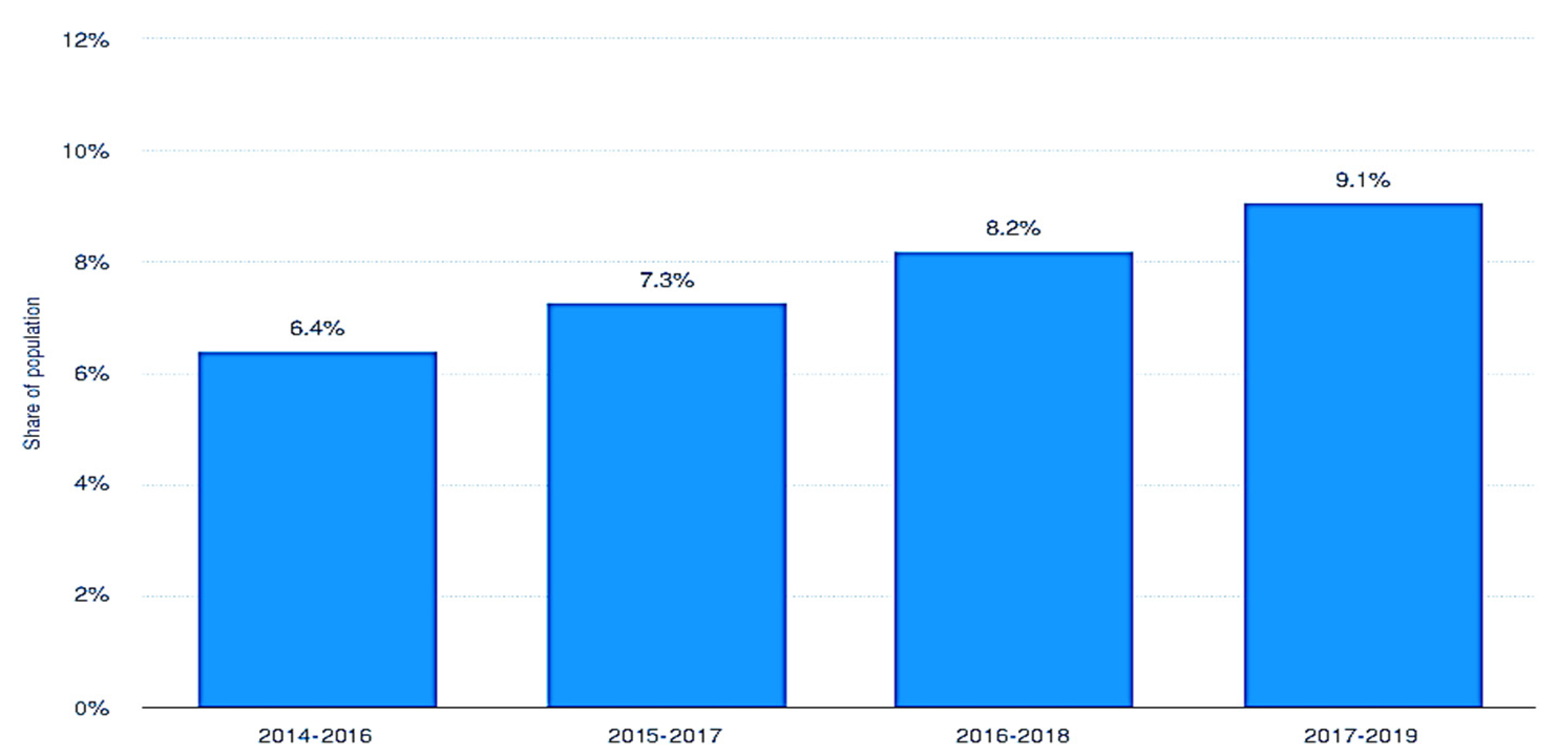
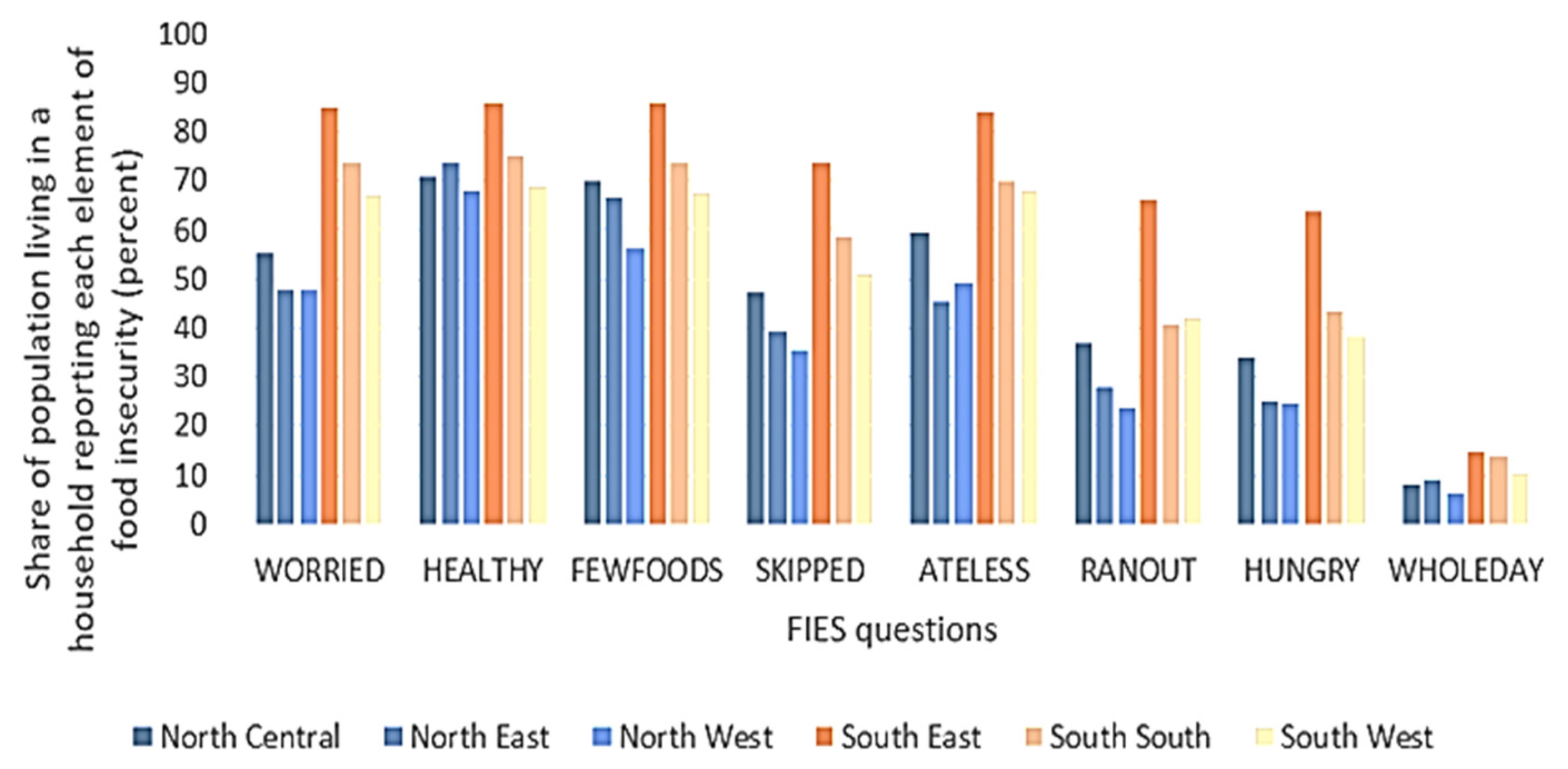

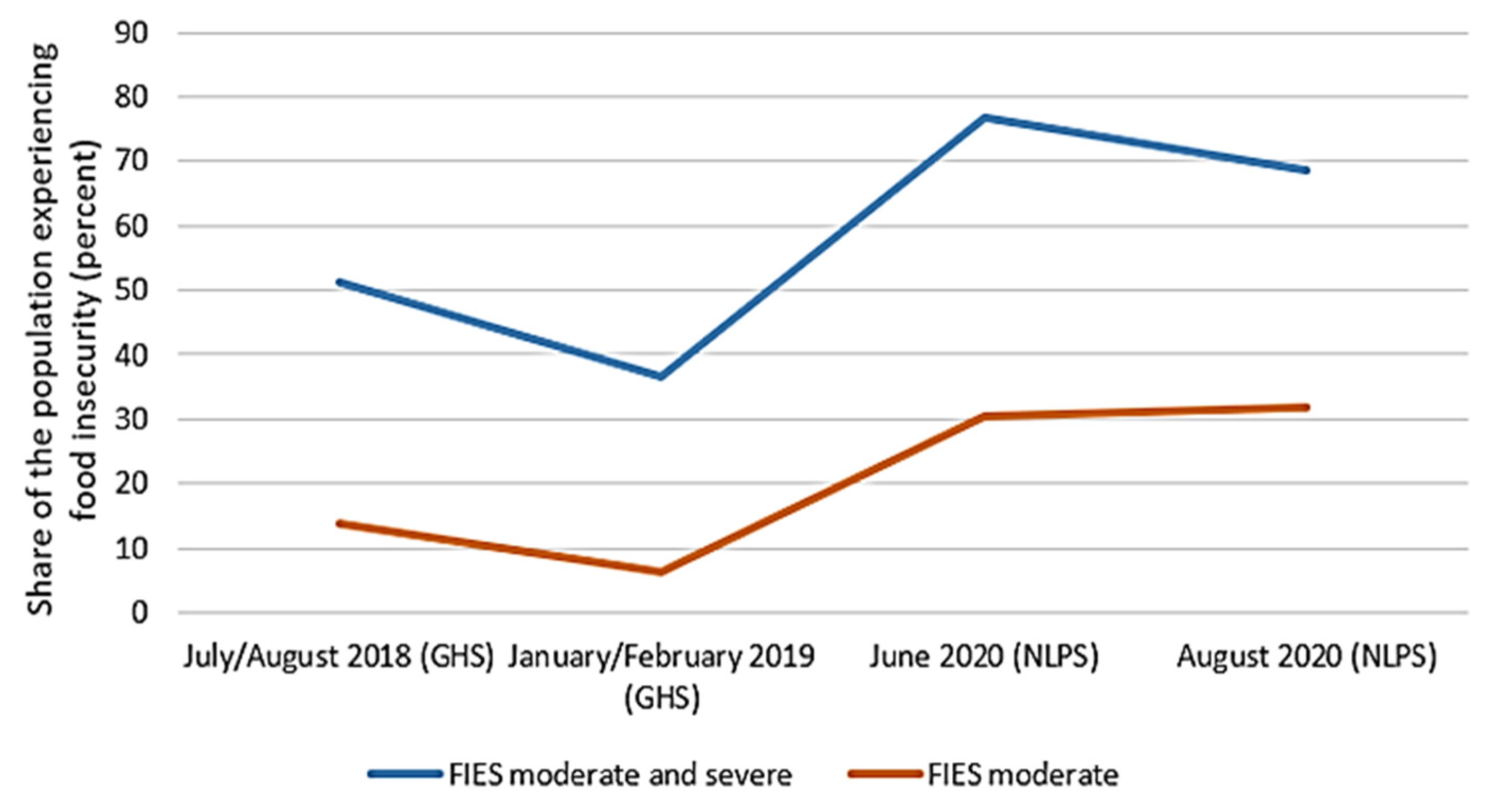


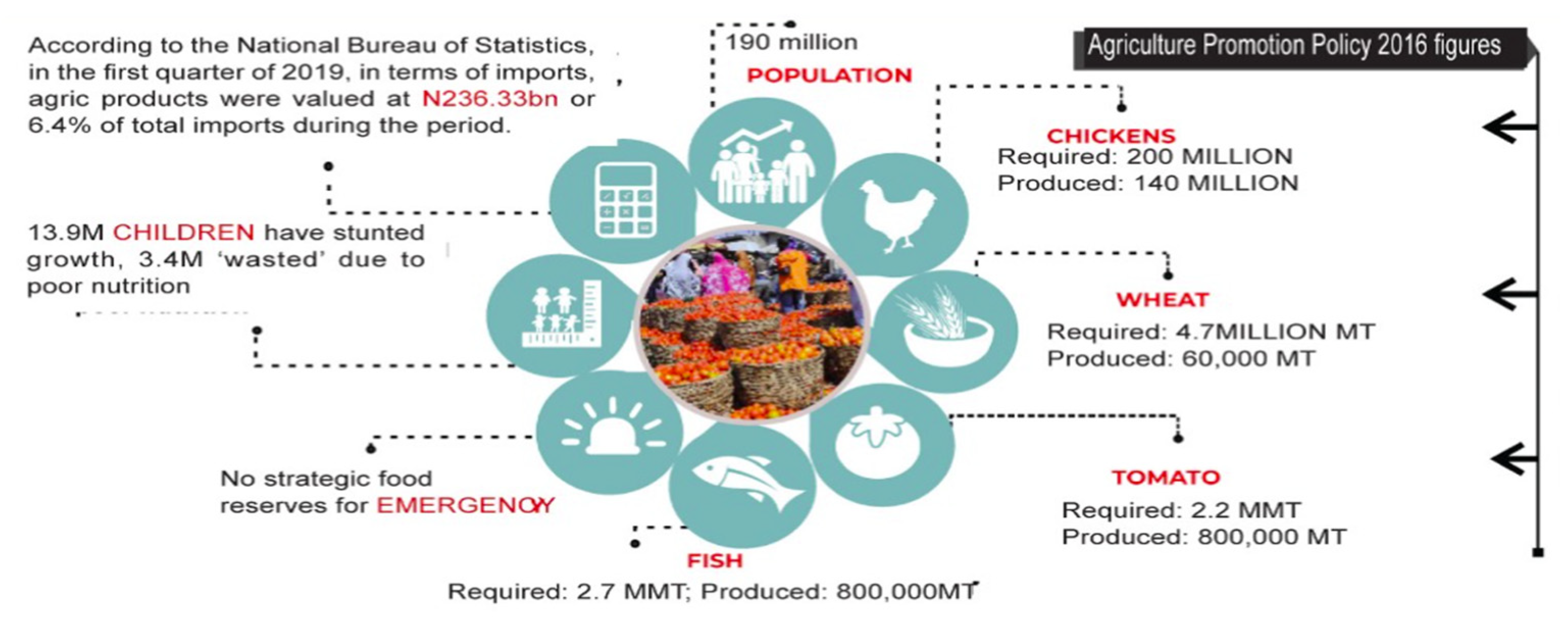
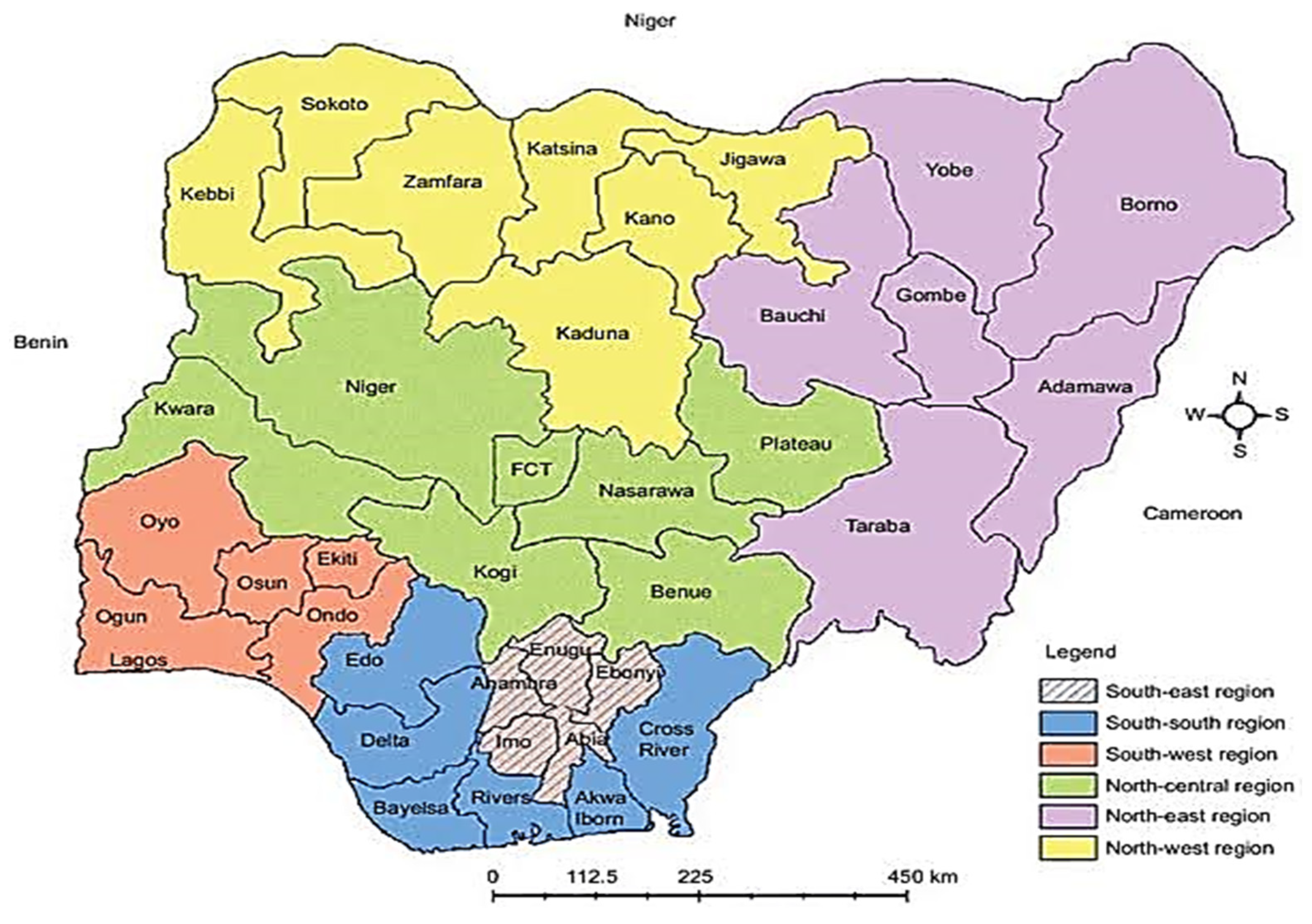



| ADF | PP | |||
|---|---|---|---|---|
| Variables | Test-Statistics | Test Statistics | Test-Statistics | Test Statistics |
| (1981–2019) | level | First Difference | Level | First Difference |
| LFPI | −3.53 | −5.00 * | −0.82 | −6.41 * |
| LAFVA | −1.94 | −7.23 * | −2.18 | −8.07 * |
| LIDP | −1.89 | −6.09 * | −1.90 | −6.10 * |
| LGDPpc | −1.47 | −3.54 ** | −2.93 | −3.54 ** |
| LPOPtl | −1.72 | 14.28 ** | −1.84 | −5.42 ** |
| LREER | −3.14 | −4.74 * | −2.18 | −4.29 * |
| LINFcp | −4.29 ** | −6.26 ** | −2.87 ** | −10.61 ** |
| Variables | LFPI | LAFVA | LIDP | LGDPpc | LPOPTL | LREER | LINFcp |
|---|---|---|---|---|---|---|---|
| Mean | 4.43 | 3.07 | 12.18 | 12.80 | 19.11 | 4.70 | 2.46 |
| Median | 4.65 | 3.05 | 12.82 | 12.80 | 19.00 | 4.71 | 2.48 |
| Maximum | 4.83 | 3.28 | 13.79 | 12.86 | 19.12 | 4.82 | 2.80 |
| Minimum | 3.52 | 2.99 | 8.52 | 12.70 | 18.85 | 4.53 | 2.09 |
| Std. Dev. | 0.49 | 0.06 | 1.57 | 0.04 | 0.08 | 0.08 | 0.21 |
| Skewness | −1.12 | 1.59 | −1.27 | −0.42 | −0.15 | −0.28 | −0.33 |
| Kurtosis | 2.54 | 5.11 | 3.45 | 3.02 | 1.76 | 1.96 | 2.18 |
| Observation | 39 | 39 | 39 | 39 | 39 | 39 | 39 |
| H0: No. of CE (s) | Eigen-Value | Trace Stat. | Prob * | Max-Stat. | Prob * |
|---|---|---|---|---|---|
| None * | 0.77 | 178.26 | 0.00 * | 54.03 | 0.00 * |
| At most 1 * | 0.71 | 124.24 | 0.00 * | 45.61 | 0.01 * |
| At most 2 * | 0.62 | 78.63 | 0.00 * | 35.95 | 0.03 * |
| At most 3 | 0.42 | 42.67 | 0.14 | 19.99 | 0.34 |
| At most 4 | 0.32 | 22.68 | 0.26 | 14.39 | 0.33 |
| At most 5 | 0.20 | 8.29 | 0.44 | 8.13 | 0.37 |
| At most 6 | 0.00 | 0.16 | 0.69 | 0.16 | 0.69 |
| K | F. Statistics | 1% Critical Values | |
|---|---|---|---|
| 6 | 6.38 | I (0) | I (1) |
| 2.88 | 3.99 | ||
| Short Term Coefficient and Error Correction Model | ||||
| Variables | Coefficient | Std. Error | T−Statistics | Probability |
| ΔLFPI (–1) | −0.01 | 0.13 | −0.11 | 0.91 |
| ΔLAFVA | 0.44 * | 0.10 | 4.227688 | 0.00 |
| ΔLIDP | −0.10 ** | 0.04 | −2.26 | 0.02 |
| Δ | 19.68 * | 2.37 | 8.31 | 0.00 |
| 0.00 * | 0.00 | 3.45 | 0.00 | |
| −60.00 * | 2.34 | −25.66 | 0.00 | |
| ΔLREER | 11.12 * | 0.55 | 20.24 | 0.00 |
| −1.13 * | 0.14 | −8.34 | 0.00 | |
| −0.013 * | 0.001 | −7.365 | 0.000 | |
| Long-Term Coefficients | ||||
| Variables | Coefficient | Std. Error | T−Statistics | Probability |
| LFPI (–1) | 0.78 * | 0.12 | 6.24 | 0.00 |
| LAFVA | 0.36 * | 0.10 | 3.59 | 0.00 |
| LIDP | 0.01 * | 0.00 | 2.72 | 0.00 |
| 0.00 | 0.00 | 1.57 | 0.13 | |
| 0.43 * | 0.13 | 3.26 | 0.00 | |
| −0.40 * | 0.11 | −3.48 | 0.00 | |
| LREER | 0.15 * | 0.05 | 2.85 | 0.00 |
| −1.05 * | 0.16 | −6.42 | 0.00 | |
| C | −6.24 ** | 2.65 | −2.36 | 0.02 |
| Test | Calculated Statistic | Probability |
|---|---|---|
| B-G-LM Test | 0.59 | 0.54 |
| B-P-G- Test | 0.17 | 0.17 |
| Jarque- | 1.22 | 0.54 |
| Ramsey RESET Test | 0.12 | 0.12 |
| Coefficient Stability Tests: | ||
| Cusum: Stable ^ Cusum(Q): Stable ^ |
| T-Statistics | Value | Df | Probability |
|---|---|---|---|
| F-Statistics | 123.34 | (6113) | 0.00 |
| Chi-square | 6 | 0.00 |
Publisher’s Note: MDPI stays neutral with regard to jurisdictional claims in published maps and institutional affiliations. |
© 2021 by the authors. Licensee MDPI, Basel, Switzerland. This article is an open access article distributed under the terms and conditions of the Creative Commons Attribution (CC BY) license (https://creativecommons.org/licenses/by/4.0/).
Share and Cite
Aliyu, U.S.; Ozdeser, H.; Çavuşoğlu, B.; Usman, M.A.M. Food Security Sustainability: A Synthesis of the Current Concepts and Empirical Approaches for Meeting SDGs. Sustainability 2021, 13, 11728. https://doi.org/10.3390/su132111728
Aliyu US, Ozdeser H, Çavuşoğlu B, Usman MAM. Food Security Sustainability: A Synthesis of the Current Concepts and Empirical Approaches for Meeting SDGs. Sustainability. 2021; 13(21):11728. https://doi.org/10.3390/su132111728
Chicago/Turabian StyleAliyu, Umar Shuaibu, Huseyin Ozdeser, Behiye Çavuşoğlu, and Mohammed A. M. Usman. 2021. "Food Security Sustainability: A Synthesis of the Current Concepts and Empirical Approaches for Meeting SDGs" Sustainability 13, no. 21: 11728. https://doi.org/10.3390/su132111728
APA StyleAliyu, U. S., Ozdeser, H., Çavuşoğlu, B., & Usman, M. A. M. (2021). Food Security Sustainability: A Synthesis of the Current Concepts and Empirical Approaches for Meeting SDGs. Sustainability, 13(21), 11728. https://doi.org/10.3390/su132111728






